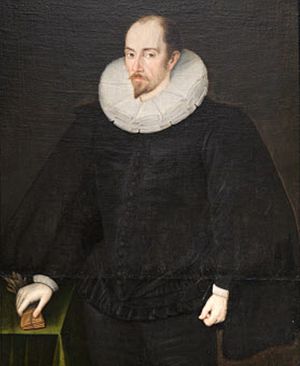Henry Cavendish (politician) facts for kids
Quick facts for kids
Sir Henry Hardwick Cavendish
|
|
|---|---|

Unknown Tudor Gentleman, possibly Henry Cavendish
|
|
| Member of Parliament for Derbyshire |
|
| In office 1572–1596 |
|
| Preceded by | Robert Wennersley |
| Succeeded by | John Harpur |
| Personal details | |
| Born | 1550 Derbyshire |
| Died | 12 October 1616 Chatsworth, Derbyshire |
| Parents | William Cavendish, Elizabeth Talbot, Countess of Shrewsbury |
Sir Henry Hardwick Cavendish (1550–1616) was an important figure in Tudor England. He was the oldest son of William Cavendish and Elizabeth Talbot, Countess of Shrewsbury, also known as "Bess of Hardwick". Henry served as a captain in the Netherlands and was a Member of Parliament (MP) for Derbyshire five times. He inherited the Chatsworth estate after his mother's death, but later sold it to his younger brother, William.
Contents
Early Life and Family
Henry Cavendish was born in December 1550. He was the first son of Sir William Cavendish, a politician, and Bess of Hardwick, a very wealthy and powerful woman. Henry was only six years old when his father passed away in 1557.
He grew up with his younger brother, William, at Chatsworth House. His mother, Bess of Hardwick, finished building Chatsworth in the 1560s. She lived there with her fourth husband, George Talbot, 6th Earl of Shrewsbury. Henry Cavendish was also a godson of Queen Elizabeth I.
In 1568, when he was 17, Henry married Grace Talbot. She was the eight-year-old daughter of his stepfather. Their wedding took place in Sheffield. However, their marriage was not a happy one, and they did not have any children together.
When Henry became an adult, he started receiving money from the lands his father had set aside for him. Before this, his mother had managed these funds.
Public Service and Career

Henry Cavendish was known for his service to England. He gained a good reputation as a soldier and also served in politics.
Military Service
As a young man, Henry Cavendish was a respected soldier. In 1578, he served as a captain in the Netherlands during the Dutch Revolt. He led about 500 men, many of whom came from his family's lands.
Cavendish and his men successfully fought off an attack by Spanish soldiers. This happened during the Battle of Rijmenam. Fighting in wars was very expensive. The costs of his campaigns in the Netherlands likely caused him to get into debt. By 1584, his debts were around £3,000.
Political Role
Cavendish began his political career in his early twenties. He became a Member of Parliament (MP) for the County of Derbyshire. He held this position for more than 20 years.
He was elected five times in a row: in 1572, 1584, 1586, 1589, and 1593. This long record of success was probably due to the influence of his stepfather, the Earl of Shrewsbury. There is no record of him speaking much in Parliament. This suggests he might not have been very interested in politics. He may have mostly enjoyed the chance to visit London.
Connection to Mary Queen of Scots
Around 1585, Henry Cavendish was living at Tutbury Castle. At this time, Mary Stuart, Queen of Scots, was being moved there as a prisoner. Cavendish was not eager to leave his home for the royal prisoner. He asked for £100 a year to use the house. He also suggested that Queen Elizabeth I lend him £2,000 to help pay his debts.
Later, he became friends with the Scottish Queen.
Travels Abroad
In 1589, Cavendish went on a trading trip to Constantinople. He wrote about his journey, and his account still exists today. In his writings, he described the city of Venice as "a most foul stinking sink."
Later Life and Legacy
Henry Cavendish had a complicated relationship with his mother. Despite being the oldest son, she did not leave him much in her will. This was because they had been distant for a long time. When his mother's marriage to the 6th Earl of Shrewsbury had problems, Henry sided with his stepfather. Bess of Hardwick called him "my bad son Henry."
Instead, his younger brother, William, inherited most of the estates his mother controlled. William later became the First Earl of Devonshire.
Henry Cavendish had children outside of his marriage. These included Henry Cavendish (1590-1626) and Anne (Cavendish) Lowe. Anne married Vincent Lowe and had a large family. Her grandson, Colonel Henry Lowe, later moved to Maryland.
Bess of Hardwick passed away on February 13, 1608. It seems Henry did not attend her funeral. He did not receive anything from her will. However, he did inherit Chatsworth House after her death, but without its valuable contents. Because of this, he sold the estate to his brother William the next year.
Henry Cavendish died on October 12, 1616, at Chatsworth, Derbyshire, England. He is buried in St Peter's Church, Edensor, Derbyshire. The Cavendish Memorial, a grand church monument from the early 1600s, honors both Henry and his brother William.
Images for kids





